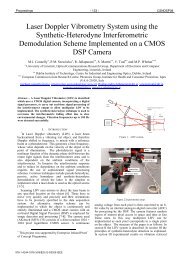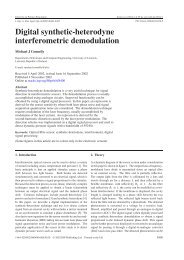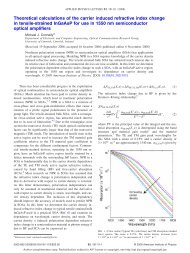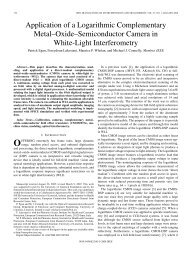Optical phase conjugation technique using four-wave mixing in ...
Optical phase conjugation technique using four-wave mixing in ...
Optical phase conjugation technique using four-wave mixing in ...
Create successful ePaper yourself
Turn your PDF publications into a flip-book with our unique Google optimized e-Paper software.
electrical power, dBm<br />
–10<br />
–20<br />
–30<br />
–40<br />
–50<br />
–60<br />
–70<br />
–80<br />
–90<br />
–100<br />
0<br />
pump<br />
conjugate<br />
1 2 3 4 5 6 7 8 9<br />
frequency, GHz<br />
Fig. 2 Measured spectrum at optical receiver output for 500 MHz<br />
modulation frequency<br />
Horizontal co-ord<strong>in</strong>ate represents frequency detun<strong>in</strong>g between laser 2 and pump<br />
and conjugate <strong>wave</strong>s. This frequency is measured <strong>in</strong> gagahertz. Vertical coord<strong>in</strong>ate<br />
represents measured electrical power measured <strong>in</strong> dBm<br />
We repeated this measurement for modulation frequencies rang<strong>in</strong>g<br />
from 0.5 to 3.5 GHz with 0.5 GHz steps. The conjugate signal power<br />
(relative to its power at 500 MHz) is shown <strong>in</strong> Fig. 3. The frequency<br />
response is not flat, as predicted <strong>in</strong> [1].<br />
relative power, dB<br />
0<br />
–2<br />
–4<br />
–6<br />
–8<br />
–10<br />
–12<br />
–14<br />
0.5<br />
1.0 1.5 2.0<br />
frequency, GHz<br />
2.5 3.0 3.5<br />
Fig. 3 Conjugate <strong>wave</strong> relative powers measured <strong>in</strong> dB<br />
Reference power is 227 dBm. Modulation frequencies are 0.5, 1, 1.5, 2, 2.5, 3<br />
and 3.5 GHz<br />
Operation conditions are same as <strong>in</strong> Fig. 1<br />
Conclusion: We have shown experimentally that, <strong>in</strong> strong contrast to<br />
exist<strong>in</strong>g <strong>technique</strong>s, SOA-based optical <strong>conjugation</strong> schemes are not<br />
necessarily restricted to the highly non-degenerate <strong>four</strong>-<strong>wave</strong> <strong>mix<strong>in</strong>g</strong><br />
regime, because the probe and conjugate <strong>wave</strong>s can propagate <strong>in</strong> opposite<br />
directions <strong>in</strong>side the SOA, as proposed <strong>in</strong> [1].<br />
Acknowledgments: This work was supported <strong>in</strong> part by the Spanish<br />
Department of Education under the Programa Nacional de Movilidad<br />
de Recursos Humanos del Plan Nacional de I + D + I 2008-2011 and<br />
Science Foundation Ireland, Pr<strong>in</strong>ciple Investigator Award (09/IN.1/<br />
II2641).<br />
# The Institution of Eng<strong>in</strong>eer<strong>in</strong>g and Technology 2011<br />
22 March 2011<br />
doi: 10.1049/el.2011.0737<br />
One or more of the Figures <strong>in</strong> this Letter are available <strong>in</strong> colour onl<strong>in</strong>e.<br />
C.L. Janer (Departamento de Ingenieria Electronica, Escuela Superior<br />
de Ingenieros, Universidad de Sevilla, Seville, Spa<strong>in</strong>)<br />
E-mail: janer@us.es<br />
M.J. Connelly (<strong>Optical</strong> Communications Research Group, Department<br />
of Electronic and Comput<strong>in</strong>g Eng<strong>in</strong>eer<strong>in</strong>g, University of Limerick,<br />
Limerick, Ireland)<br />
References<br />
1 Agrawal, G.P.: ‘Population pulsation and nondegenerate <strong>four</strong>-<strong>wave</strong><br />
<strong>mix<strong>in</strong>g</strong> <strong>in</strong> semiconductor lasers and amplifiers’, J. Opt. Soc. Am. B.,<br />
1988, 5, (1), pp. 147–159<br />
2 Fu, T., and Sargent, M. III.: ‘Effects of signal detun<strong>in</strong>g on <strong>phase</strong><br />
<strong>conjugation</strong>’, Opt. Lett., 1979, 4, (11), pp. 366–368<br />
3 He, G.S.: ‘<strong>Optical</strong> <strong>phase</strong> <strong>conjugation</strong>: pr<strong>in</strong>ciples, <strong>technique</strong>s and<br />
applications’, Prog. Quantum Electron., 2002, 26, pp. 131–191<br />
4 Yariv, A., Fekete, D., and Pepper, D.M.: ‘Compensation for channel<br />
dispersion by nonl<strong>in</strong>ear optical <strong>phase</strong> <strong>conjugation</strong>’, Opt. Lett., 1979, 4,<br />
(2), pp. 52–54<br />
5 Bogatov, A.P., Eliseev, P.G., and Sverdlov, B.N.: ‘Anomalous<br />
<strong>in</strong>teraction of spectral modes <strong>in</strong> a semiconductor laser’, IEEE<br />
J. Quantum Electron., 1975, 11, pp. 510–515<br />
6 Fabre, F., and Guen, D. le: ‘Contradirectional <strong>four</strong>-<strong>wave</strong> <strong>mix<strong>in</strong>g</strong> <strong>in</strong><br />
1,51 mm near-travell<strong>in</strong>g-<strong>wave</strong> semiconductor laser amplifier’, Electron.<br />
Lett., 1989, 25, (16), pp. 1053–1055<br />
7 Xue, W., Chen, Y., Ohman, F., Sales, S., and Mork, J.: ‘Enhanc<strong>in</strong>g light<br />
slow-down <strong>in</strong> semiconductor optical amplifiers by optical filter<strong>in</strong>g’, Opt.<br />
Lett., 2008, 33, (10), pp. 1084–1086<br />
8 Erdogan, T.: ‘Fiber grat<strong>in</strong>g spectra’, IEEE J. Light<strong>wave</strong> Technol., 1997,<br />
15, (8), pp. 1277–1294<br />
ELECTRONICS LETTERS 9th June 2011 Vol. 47 No. 12






